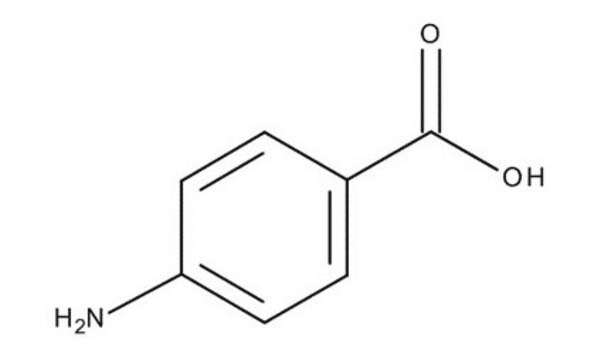100536
4-Aminobenzoic acid
99%, for peptide synthesis, ReagentPlus®
Sinonimo/i:
PABA, Vitamin Bx, Vitamin H1
About This Item
Prodotti consigliati
product name
4-Aminobenzoic acid, ReagentPlus®, 99%
Livello qualitativo
Nome Commerciale
ReagentPlus®
Saggio
99%
Forma fisica
solid
Impiego in reazioni chimiche
reaction type: solution phase peptide synthesis
Punto di fusione
187-189 °C (lit.)
Solubilità
95% ethanol: soluble 5%, clear to slightly hazy, colorless to yellow
Densità
1.374 g/mL at 25 °C (lit.)
applicazioni
peptide synthesis
Stringa SMILE
Nc1ccc(cc1)C(O)=O
InChI
1S/C7H7NO2/c8-6-3-1-5(2-4-6)7(9)10/h1-4H,8H2,(H,9,10)
ALYNCZNDIQEVRV-UHFFFAOYSA-N
Cerchi prodotti simili? Visita Guida al confronto tra prodotti
Categorie correlate
Descrizione generale
Applicazioni
- Covalent modification of glassy carbon electrode.
- Synthesis of 1,4-(2-chlorobenzylidene)aminobenzoic acid (Schiff base).
- Spectrophotometric determination of the trace amounts of dopamine, methyldopa and levodopa.
- Synthesis of 1:1 proton-transfer compound with 5-sulfosalicylic acid.
Note legali
Indicazioni di pericolo
Consigli di prudenza
Classi di pericolo
Aquatic Chronic 3
Codice della classe di stoccaggio
11 - Combustible Solids
Classe di pericolosità dell'acqua (WGK)
WGK 2
Punto d’infiammabilità (°F)
339.8 °F - closed cup
Punto d’infiammabilità (°C)
171 °C - closed cup
Dispositivi di protezione individuale
dust mask type N95 (US), Eyeshields, Faceshields, Gloves
Certificati d'analisi (COA)
Cerca il Certificati d'analisi (COA) digitando il numero di lotto/batch corrispondente. I numeri di lotto o di batch sono stampati sull'etichetta dei prodotti dopo la parola ‘Lotto’ o ‘Batch’.
Possiedi già questo prodotto?
I documenti relativi ai prodotti acquistati recentemente sono disponibili nell’Archivio dei documenti.
I clienti hanno visto anche
Il team dei nostri ricercatori vanta grande esperienza in tutte le aree della ricerca quali Life Science, scienza dei materiali, sintesi chimica, cromatografia, discipline analitiche, ecc..
Contatta l'Assistenza Tecnica.









